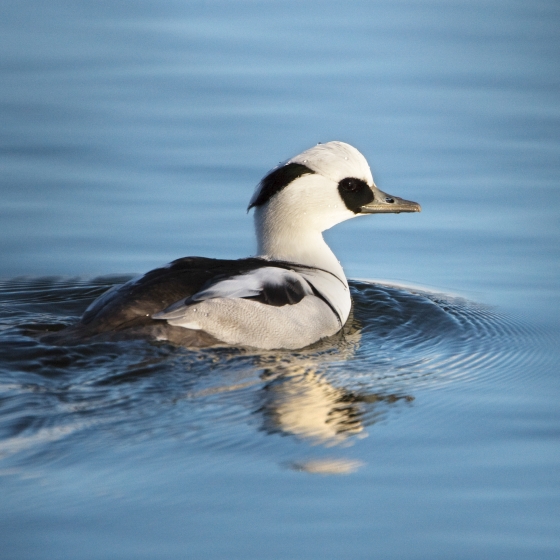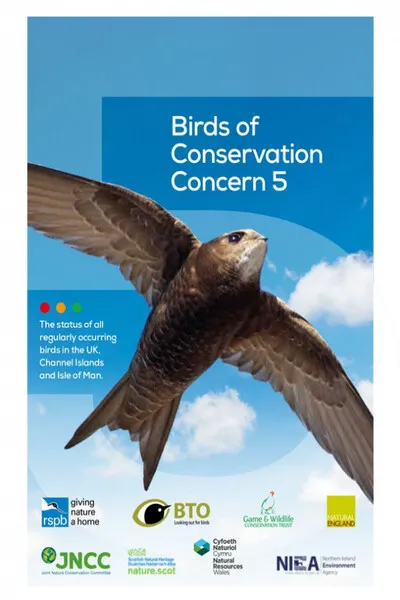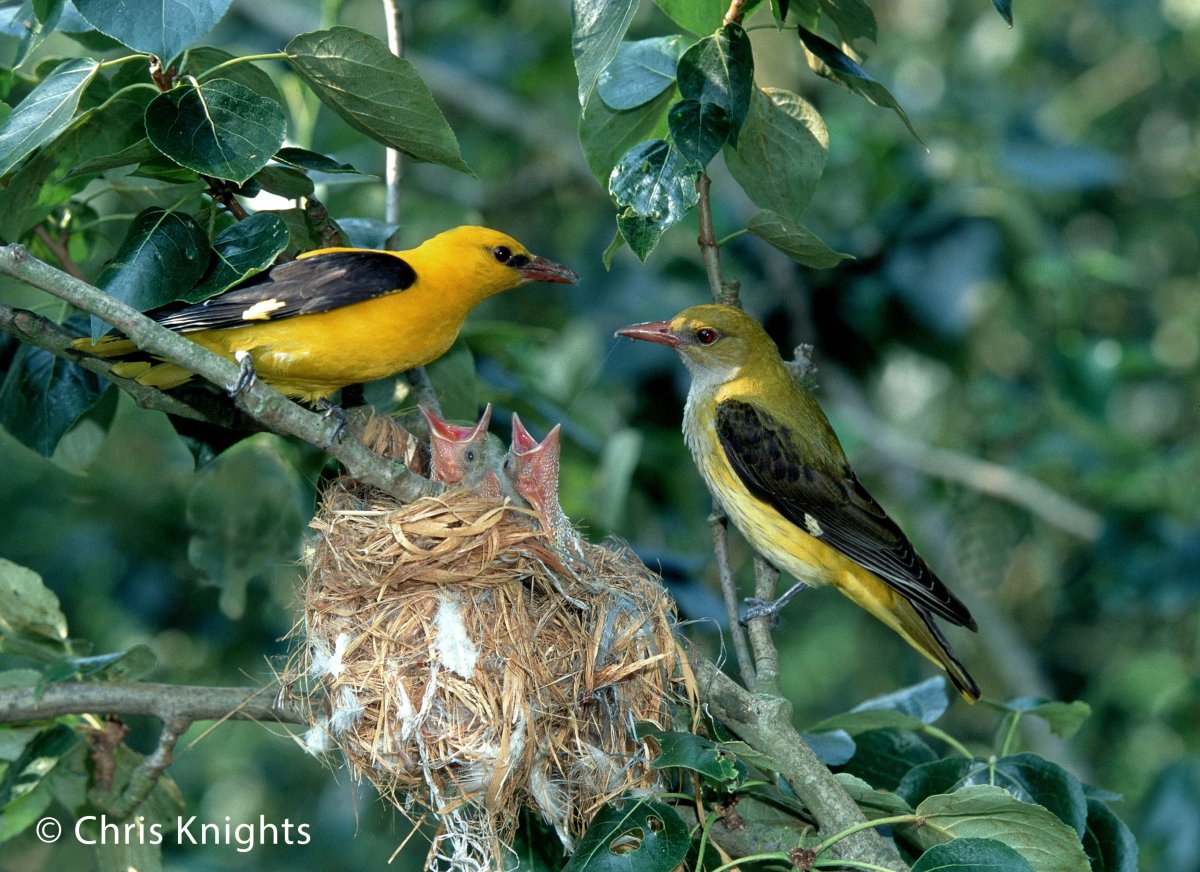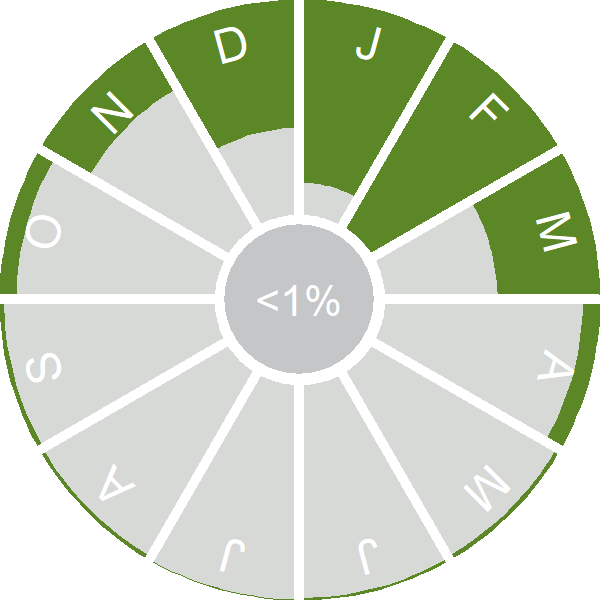Smew

Introduction
Crisp black and white-coloured male and red-headed female Smew are winter visitors to UK lakes, reservoirs and coastal waters.
Smew begin arriving in the UK during October but have a prolonged period of movements throughout the winter and birds can arrive at any time in response to freezing conditions on their Continental wintering areas. The south-east of the UK receives the lion's share but a few individuals do make it further west. Records are scarce in Scotland, Wales and Ireland.
The numbers of Smew wintering in the UK has fallen in recent years, possibly in response to milder conditions on the Continent, which maintain waterbodies free of ice for longer.

Key Stats
Status and Trends
Conservation Status
Population Size
Population Change
Although there are occasional records of individual Smew in the UK in the summer months, it is primarily a winter visitor; recent estimates show the winter population to comprise approximately 130 individuals Frost et al. 2019]. The species is found across lowland areas of England, Scotland and Wales, with numbers increasing in colder winters when small influxes occur as birds escape colder conditions on the Continent [Balmer et al. 2013]. It is a species that is strongly associated with gravel pit complexes with the majority of the wintering population found in this habitat [Austin et al. 2014]. [WeBS data show that numbers peaked in the the mid-1990s, since when they have declined sharply.
Distribution
The Smew's winter distribution map shows that they were recorded widely across lowland England, Scotland and Wales during 2007–11. There were also records from the Isle of Man and the Channel Islands, where they are scarce winter visitors.
Occupied 10-km squares in UK
or view it on Bird Atlas Mapstore.
or view it on Bird Atlas Mapstore.
European Distribution Map
Distribution Change
Change in occupied 10-km squares in the UK
or view it on Bird Atlas Mapstore.
Seasonality
Smews are localised winter visitors, most often recorded in late winter when cold weather on the continent can push birds into southern Britain.
Weekly pattern of occurrence
The graph shows when the species is present in the UK, with taller bars indicating a higher likelihood of encountering the species in appropriate regions and habitats.

Movement
Britain & Ireland movement
European movements
EuroBirdPortal uses birdwatcher's records, such as those logged in BirdTrack to map the flows of birds as they arrive and depart Europe. See maps for this species here.
The Eurasian-African Migration Atlas shows movements of individual birds ringed or recovered in Europe. See maps for this species here.
Biology
Productivity and Nesting
Nesting timing
Egg measurements
Clutch Size
Fledging
Survival and Longevity
Survival is shown as the proportion of birds surviving from one year to the next and is derived from bird ringing data. It can also be used to estimate how long birds typically live.
Classification, names and codes
Classification and Codes
- Order: Anseriformes
- Family: Anatidae
- Scientific name: Mergellus albellus
- Authority: Linnaeus, 1758
- BTO 2-letter code: SY
- BTO 5-letter code: SMEW.
- Euring code number: 2200
Alternate species names
- Catalan: bec de serra petit
- Czech: morcák malý
- Danish: Lille Skallesluger
- Dutch: Nonnetje
- Estonian: väikekoskel e. pudukoskel
- Finnish: uivelo
- French: Harle piette
- Gaelic: Sìolta-bhreac
- German: Zwergsäger
- Hungarian: kis bukó
- Icelandic: Hvítönd
- Irish: Síolta Gheal
- Italian: Pesciaiola
- Latvian: maza gaura, duncka
- Lithuanian: mažasis danciasnapis
- Norwegian: Lappfiskand
- Polish: bielaczek
- Portuguese: merganso-pequeno
- Slovak: potápac malý
- Slovenian: mali žagar
- Spanish: Serreta chica
- Swedish: salskrake
- Welsh: Lleian Wen
- English folkname(s): White Nun (m) Redhead (f)
Research
Causes of Change and Solutions
Causes of change
Several species of diving ducks have shifted their wintering range in a more north-easterly direction over the past three decades due to an increase of 3.8°C in the north-eastern part of the wintering range in early winter [Lehikoinen et al. 2013]. The reduction of Smew numbers in the UK is thought to be a related to this shift, as evidenced by the increase in Smew in Sweden from 400 birds in 1971 to 3,800 in 2004 [Nilsson 2008].
Publications (2)
The status of our bird populations: the fifth Birds of Conservation Concern in the United Kingdom, Channel Islands and Isle of Man and second IUCN Red List assessment of extinction risk for Great Britain
Author: Stanbury, A.J., Eaton, M.A., Aebischer, N.J., Balmer, D., Brown, A.F., Douse, A., Lindley, P., McCulloch, N., Noble, D.G. & Win, I.
Published: 2021
Commonly referred to as the UK Red List for birds, this is the fifth review of the status of birds in the UK, Channel Islands and Isle of Man, published in December 2021 as Birds of Conservation Concern 5 (BOCC5). This updates the last assessment in 2015. Using standardised criteria, experts from a range of bird NGOs, including BTO, assessed 245 species with breeding, passage or wintering populations in the UK and assigned each to the Red, Amber or Green Lists of conservation concern.
01.12.21
Reports Birds of Conservation Concern

The risk of extinction for birds in Great Britain
Author: Stanbury, A., Brown, A., Eaton, M., Aebischer, N., Gillings, S., Hearn, R., Noble, D., Stroud, D. & Gregory, R.
Published: 2017
The UK has lost seven species of breeding birds in the last 200 years. Conservation efforts to prevent this from happening to other species, both in the UK and around the world, are guided by species’ priorities lists, which are often informed by data on range, population size and the degree of decline or increase in numbers. These are the sorts of data that BTO collects through its core surveys.
01.09.17
Papers


